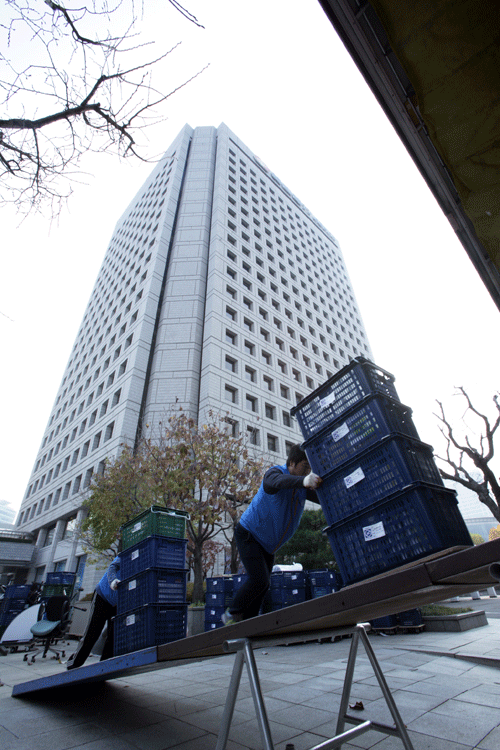Sets up an integrated ICT Center in new “Energy Valley’
Opening its new era of leaping forward, KEPCO (President: Cho Hwan-ik) moved its headquarters in November 2014 from Seoul to Naju, an innovative city near Gwangju Metropolitan City with a population of around 90,000 in Jeollanam-do. KEPCO’s head office had been located in Samseong-dong, Seoul for 28 years. The new 33-story building (2 stories underground and 31 stories above ground) with total floor space of approximately 100,000 square meters of the electric power company is equipped with renewable energy generation facilities with a capacity of 6,700kW (including geothermal energy of 4,600kW and solar photovoltaic power of 2,100kW) that can generate 23 million kWh per year, supplying 42% of entire energy demand of the building. The energy-producing building will initially accommodate over 1,530 employees. In terms of sales and size of assets, KEPCO is the largest company in two southwestern provinces.

At the same time, KEPCO also moved its integrated power ICT center from Seoul to a separate new building in Naju that is connected with over 290 regional ICT operations across the country. To secure safety even in earthquake, the new 4-story building of the ICT data center is designed to be earthquake-resistant, aiming to achieve high grade in Uptime Tier-III. The facility is also designed to maximize energy efficiency to reduce power consumption by 25%. It will provide seamless ICT service environment around the clock to customers as well as some 20,000 employees of KEPCO across the country, with operation ratio of 99.982%.
With the move of its headquarters to this region, KEPCO plans to take an initiative in building the ‘Bitgaram Energy Valley’ in the region as part of its strategy to drive economic development of the region. The largest electric power company in Korea aims to establish an electric power industry-based ‘global+local’ region of innovative and creative economy that can generate synergy for regional development in connection with the advanced industry belt in Gwangju region, IT convergence industry belt in southeast region, and renewable energy industry belt in southwest region. In an effort to expedite establishment of the ‘Bitgaram Energy Valley’, KEPCO formed a council participated by 27 organizations and agencies in the region.
In conjunction with related organizations, KEPCO will expand collaboration for R&D with industry, academia and research institutions and establish a cradle for educating manpower. To this end, the company will invest over 10 billion won (approximately $8.97 million) in R&D projects every year jointly with its group affiliates, including KEPCO KPS and KEPCO KDN, and develop new promising technologies in varied areas, such as renewable energy, energy storage system (ESS), micro grid, electric vehicle-charging infrastructure and direct current (DC) distribution. And, in order to educate excellent manpower in these areas, the company will expand collaboration with universities and colleges in the province, increase chances of taking part in R&D projects of its electric power research institute by graduate school students, expand training of college students at its in-house college, provide energy manpower training programs to meister high school students in the region, and offer advantages to applicants from the region in recruiting employees.
With the goal of attracting 100 small and mid-sized energy companies with advanced technologies to the ‘Energy Valley’ and achieving ecosystemic growth with them, KEPCO will foster small giant companies in the region by providing substantial support to them in conjunction with local governments, while building symbiotic relationships in processes ranging from developing products to their export. To promote ecosystemic growth, KEPCO will provide outcome-creating consulting service and KEPCO Trusted Partnership (KTP) certificate to small companies in the ‘Energy Valley’, and install a ‘Business Plaza for Small and Mid-sized Companies’ in its new building in Naju.

In addition, in order to improve energy efficiency in the ‘Energy Valley’, KEPCO will build integrated and smart energy management system for organizations and companies in the region, leveraging its electric power-ICT convergence technology. Through this, it will improve energy efficiency by 10% by 2020 by comprehensively managing demand of energy in the region based on information on amount of power generated by renewable energy facilities installed at companies and organizations as well as that on amount of energy consumed at these organizations. And then it plans to take part in the ‘NegaWatt’ power generation market jointly with other organizations.
Also, it will build a renewable energy cluster in the region by setting up a comprehensive micro grid operation center for numerous islands in Jeollanam-do, constructing a tidal current power plant and offshore wind power generation farms on islands, building eco-friendly energy parks, and by installing solar photovoltaic power generation facilities on rooftops of some 300 social welfare facilities in the province. Moreover, it aims to establish the ‘Green Energytopia’ environment in the region by developing and applying ‘small and safe home’ service based on ICT convergence technology, contributing to invigoration of regional economy and balanced development of the nation.

